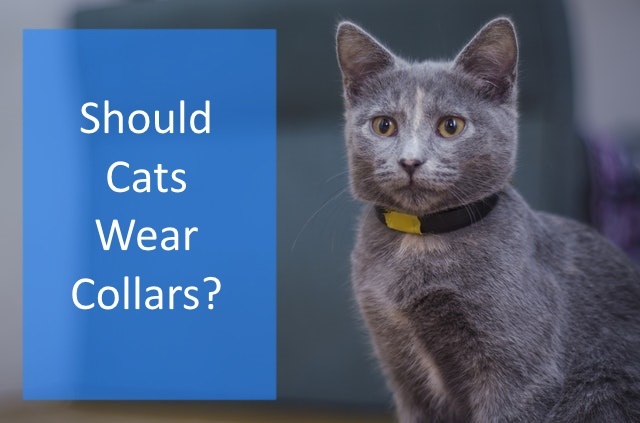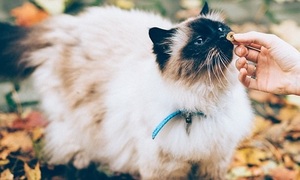
It may seem like common sense, especially to anyone that has a dog that goes outside on a consistent basis, but placing identification on our pets is a pretty basic expectation for a pet owner. Unfortunately a lot of family cats become lost without a collar (or any form of identification) on them and thus have a very difficult time finding their way home.
It would be a shame to lose your cat over something so simple! And the sad truth of it is that a lot of cats do manage to get outside, even cats that are 100% indoor cats.
They get out all the time. Someone leaves the door open on accident, a friend visits and doesn’t know you have a cat, you’re picking up a package from Amazon. There are a laundry list of ways your cat can get out, and most cats are adventurous enough that they will likely get outside at some point.
There are a couple of major options out there from an identification standpoint:
- Internal microchip identifiers
- Collars with identification tags
- Tattoos on the ear or inner thigh
The simple fact of the matter is a collar with an identification tag is by far the most obvious and easiest type of ID for people to see. They are very visible and they let people know immediately that this cat is not a stray/feral. On top of this, many people might not even be aware that internal microchips or tattoos are potential options and thus not think to check for them.
So if you’re asking yourself should cats wear collars, the answer is a resounding yes! But a lot of people are absolutely sure their cat simply won’t wear a collar. Let’s dig into this myth and then talk about your cat wearing a collar!
My Cats Won’t Wear A Collar – I’m Sure Of It!
The most common reason we humans push back on the idea of putting a collar on our pet is because we are certain that our cat simply won’t have it. The interesting thing is, in a study of over 500 cats over a 6 month period of time, about 73% of cats still had their collar on.
The study also found that the biggest predictive factor in whether or not a cat would keep the collar on was the owner’s initial expectation on whether or not it would stay on. What’s that mean? It means if you don’t think your cat will like collars you’re a heck of a lot more likely to give up and simply go without the collar. Self fulfilling prophecy anyone?
The last major conclusion from the study was “Because even house cats can become lost, veterinarians should recommend that all cats wear identification collars since they are the most obvious means of identifying an owned pet.” Pretty pointed.
I’ve Tried a Collar – My Cat Hated It!
If you’ve had your cat for any extended period of time you’re probably familiar with the fact that cats don’t particularly love new things. While this is normally associated with people, additional pets & places, it also applies to collars. You need to take a gradual approach with your cat when it comes to a new collar.

Most cats won’t take kindly to simply having a collar strapped on with no introduction.
Start without tinkling tags or jingling bells. Place the properly fitted collar on your pet for 10 minutes or, if the pet does not appear to object, for a few supervised hours. Reward the pet with a treat and playtime and remove the collar. Replace and remove the collar multiple times over a few days, until your pet is comfortable and associates wearing the collar with great things — fun time with you!
Repeat the process after adding identification and rabies-vaccination tags. A pet who has never worn a collar should not be left unsupervised until you are certain he or she has accepted it. A positive introduction to a collar will make your pet far more comfortable wearing one permanently.
What About the Noise? Won’t It Drive Me Nuts?
If your cat is an outdoor cat you’re going to need a lot of different information on the collar, particularly things like a rabies tag, a name tag and of course a license tag if you so happen to live in the good old state of Rhode Island. While your cat may make some noise based on all of these tags, you’re likely to find that over time your cat will actually figure out how to move without making too much noise even with all these tags and a bell.

- Tag Silencers: A tag silencer does exactly what it says, it is basically a simple sheath to put the tag inside that is made of a softer pliable material that won’t make noise as it bounces against other tags or even the D ring fitted to most collars.
- Riveted Tags: As opposed to the standard application of a tag hanging on the D ring, a riveted tag will actually be attached directly to the fabric of the collar. You’ll commonly see this on nylon style collars.
- Slip On Tags: A few new companies are out there with their own method of a sliding tag built right into the collar itself. If you order directly from them you can have the tag engraved before it ever arrives.
- Direct Application: Many collars can be written on or you can even have some collars embroidered with the name and contact information of your cat. These are wonderful options if you want to avoid tags all together, but if you use any form of ink be sure to renew it as over time it will certainly fade.

 Are There Any Other Benefits To Collars?
Are There Any Other Benefits To Collars?
One other huge benefit a collar brings is that it can be used to store medical information about your cat. If you have any friends that have severe allergies to specific medications then you might notice them wearing a medical bracelet that lets doctors know not to administer certain types of medication.
If you have a special needs cat then you can dual use their collar and tags for the same purpose we humans have them. This is most common for cats that might be diabetic or have a severe allergy.
 What If I’ve Tried A Collar And It Failed?
What If I’ve Tried A Collar And It Failed?
If your cat is one of those that can’t stand the collar after an extended period of trying it out then you do have alternatives. The best and most effective alternative on the market is by far the Microchip. There are a wide variety of companies that create microchips for cats, but some of the most common & their details are:
Avid makes Friendchip, an encrypted 125 kHz microchip
- HomeAgain makes a Schering-Plough distributed, unencrypted 125 kHz microchip
- HomeAgain also makes a 134.2 kHz microchip distributed by Schering-Plough
- 24PetWatch is an unencrypted 125 kHz microchip made by Allflex (a newcomer?)
- AKC-CAR is a 128 kHz microchip made by Trovan
- ResQ is a 134.2 kHz microchip made by Bayer
One thing many owners ask about microchips is what information is stored on the chip itself. It is important to note that the only information on a microchip is a unique identifier. Even if an individual finds your pet the only information they can get from the microchip itself is a unique identifier which is used to contact the company that issued it so they can get in contact with the pet owner.
Are Any Other Options Out There?
Last but not least you can consider a tattoo as well. While tattoos these days are most widely used on pets to indicate that a female has been spayed (neutering is a bit more obvious), “identification tattoos” are also registered markings that can also help your cat find her way home.
The key drawback of tattoos though is that similar to ink on a collar, over time they will fade and become difficult to read. On top of this tattoos are a heck of a lot less obvious than a collar with tags on it and an unwitting good Samaritan could not even think to look for a tattoo.
Are All Collars Safe?
It is worth noting that there are a laundry list of collar types and formats on the market. Not all collars are going to be safe for your cat. The most important thing to look for is what is called a Safety Collar or a Breakaway Collar.
The general idea behind these is that if your cat’s collar happens to get caught on something (a tree branch, a fence post, etc.) then the collar will purposely release so your caught doesn’t end up choking while hanging from the collar. Pretty slick design! And most of them pop off at about 4-5 lbs of pressure which is plenty for any adult cat.
What About Flea Collars
There are some flea collars out there that have built in safety mechanisms like other break away collars, but they are not the norm. If you can’t find a break away flea collar then I wouldn’t recommend one.
If you’re looking for flea protection for your outdoor cat then consider a spray or a wash. Check out this quick guide for some of the best Flea Sprays out there.

Wrapping it Up on Should Cats Wear Collars
There are a lot of options out there to keep your cat safe and sound and ensure they get back home to you. Microchips are often touted as the best method since they cannot be lost and there is no battery associated. The unfortunate part of microchips is that they are invisible to the naked eye and 99% of people don’t have a microchip scanner meaning your cat needs to get to a shelter or city animal control center.
A collar and ID tag is by far the most obvious method and everyone can see it plain as day. Pretty much anyone can read the name and phone number off of a collar and give you a call if they happen across your lost pet. This is the reason that I recommend keeping a collar on your kitties even if they are already chipped.
At the end of the day there’s no such thing as too much ID, especially for a lost pet and a distraught family. Check Out the Top 10 Seasonal Cat Collars from StuffCatsWant.com.
Please leave a comment below or email me directly at Craig@StuffCatsWant.com if you have any thoughts to add to this article.
StuffCatsWant.com is a participant in the Amazon Services LLC Associates Program, an affiliate advertising program designed to provide a means for sites to earn advertising fees by advertising and linking to Amazon.com.
Sources: Evaluation of Collars and Microchips, Search and Identification Methods, Animal Laws, PetMD MicroChip Information

 Are There Any Other Benefits To Collars?
Are There Any Other Benefits To Collars?
